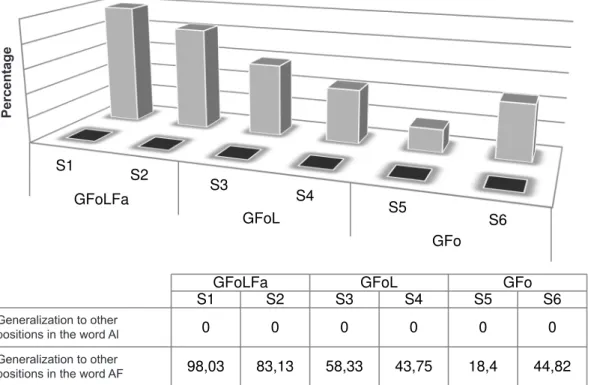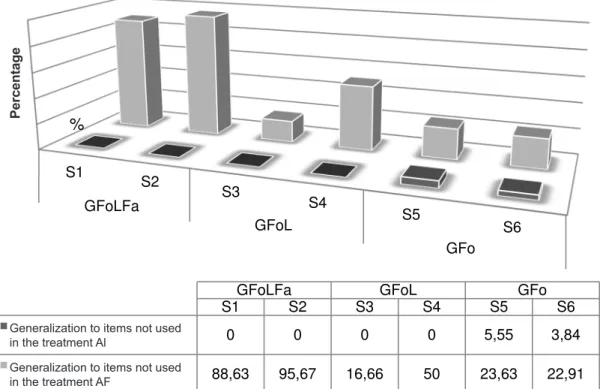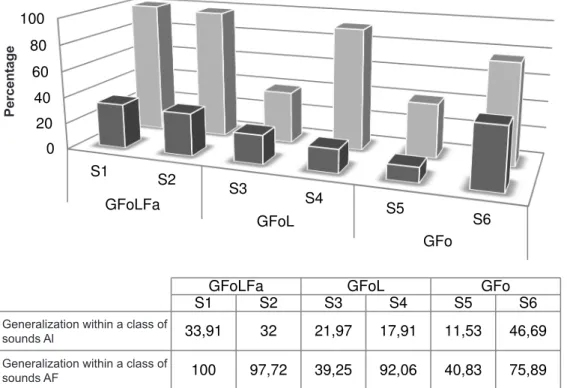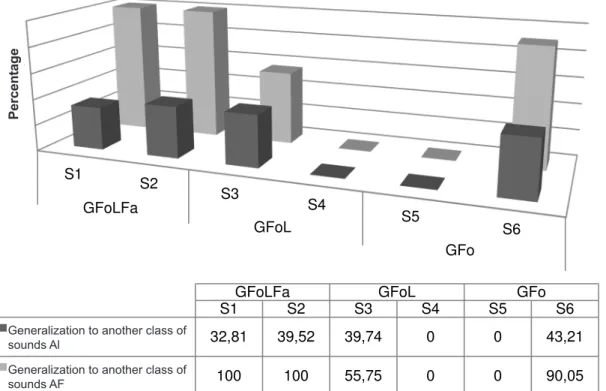STRUCTURAL GENERALIZATION BY CHILDREN
WITH SPEECH-SOUND DISORDERS UNDER DIFFERENT
THERAPEUTIC APPROACHES
Generalização estrutural obtida por crianças com desvio fonológico
submetidas a diferentes abordagens terapêuticas
Marileda Barichelo Gubiani(1), Márcia Keske-Soares(1)
(1) Universidade Federal de Santa Maria – UFSM, Santa
Maria, RS, Brasil.
Conlict of interest: non-existent
production mechanism, and it happens when there are substitutions and deletions of speech sounds.
There are different phonological models for treating speech-sound disorders. The main goal of these therapeutic models is to make the phono
-logical system fully functional, as well as to stimulate generalization. In addition to traditional phonological therapy, other strategies are being used to make phonological therapy quicker and promote a greater number of generalizations6.
Generalization occurs when a sound not trained in therapy is acquired through work performed at another sound. Generalization is the extension or transfer of learning, i.e., the occurrence of treated sounds in other untreated contexts or words. Generalization can also occur within a class of
INTRODUCTION
Speech is a complex function1,2 and it is acquired
gradually until the phonological system is stable, in accordance with the linguistic community where the child grows up3. Previous studies4,5 stated that
speech is directly related to the stomatognathic system and there is an association between the perception and production of ine motor function.
When speech acquisition is delayed or impaired, it is a speech-sound disorder that is affecting a child’s linguistic organization, rather than the child’s speech
ABSTRACT
Purpose: to verify which group (with or without stimulation of orofacial praxis skills) presented better structural generalizations by considering the following types: Related to items not used in the treatment, to another position in the word, within a class of sounds, and to another class of sounds. Methods: the sample consisted of six subjects (three girls and three boys), with ages between 5:4 and 7:0 at the beginning of therapy. The subjects were divided into three groups, all received phonological therapy through the model of Minimal Pairs Maximum / Empty Set oppositions, being those of the study group treated with stimulation of face and tongue praxis skills (GFoLFa), and with exercises of tongue praxis skills (GFoL), and the control group was subjected only to phonological therapy (GFO). All were assessed before and after therapy as to the phonological system (Yavas,Hernandorena and Lamprecht, 1991); also the Orofacial Praxis Test (Berzoatti, TavanoandFabbro, 2007), and the Bucofacial Articulatory Praxis test (Hage, 2000). Result: the GFoLFa achieved major developments to generalizations for the four types analyzed (within a class of sounds to other positions in the word, to another class of sounds and in items not used in the treatment). The GFoL presented a substantial number of generalizations within a class of sounds; and the GFO had presented generalization to another class of sounds. Conclusion: the groups that received praxis intervention obtained greater generalizations; however, we suggest new studies applying this model, in order that with other samples these results can be conirmed.
participation in the research and the publication of
results.
The subjects were six children aged between 64 and 86 months, both males and females, previously diagnosed with a speech-sound disorder by means of speech screening in a speech therapy service at a Higher Education Institution.
For acceptance as participants in the study, subjects had to meet some speciic requirements: previous diagnosis of a speech-sound disorder, two sounds missing from their phonetic inventory, hearing within normal limits and no signiicant changes in speech-sound assessments and complementary assessments, except for phono
-logical10 and orofacial praxis assessments11,12.
In order to conirm the diagnosis of speech-sound disorder and to rule out other impairments that could interfere with language development, the subjects underwent the following speech-sound assessments: anamnesis, receptive and expressive language skills, stomatognathic system, articulatory examination, auditory discrimination, simpliied auditory processing, phonological awareness, orofacial praxis and phonological assessment. Moreover, all participants underwent the following additional assessments: screening of the external auditory canal and auditory screening.
After the assessments, the children were referred for therapy and were divided into three groups. One group received phonological therapy (GFo), the second group received phonological therapy and tongue praxis exercises (GFoL) and the third group, in addition to phonological therapy and tongue praxis exercises, had an intervention on orofacial praxis (GFoLFa).
The children received phonological therapy based on the Minimal Pair / Maximal Oppositions
Model13, according to changes proposed in the
literature14.
The intervention on tongue praxis skills were based on a previous study15, while the intervention
on facial praxis skills was based on the assessment of orofacial praxis skills11,12.
The analysis of structural generalizations was based on the initial and inal phonological assess
-ments, made with a phonological assessment instrument10, measured as follows:
• generalization to items not used in the treatment: the development of target sounds used in the treatment was compared in the initial and inal assessments (mean of comparative percentages);
• generalization to other positions in the word: all subjects were treated with target sounds in the medial onset position; thus, this generalization was obtained after checking other possible sounds or other classes of sounds7. In clinical
practice, generalization contributes to making therapy more eficient and faster, avoiding the need to train all incorrect sounds in all words, contexts or environments8.
Generalization can be researched from two perspectives - one seeks to identify the structural aspects of generalization or the circumstances in which generalization occurs, whereas the other perspective examines the functional properties of generalization or how it is used by a child to change their phonological system. The second perspective takes intra-subject variables into account, e.g. linguistic maturity, cognitive functioning and children’s motor skills9.
The irst type of generalization abovementioned has the following structural components: general
-ization to items not used in the treatment, to another position in the word; within a class of sounds, to other classes of sounds, and based on implicational
relations.
In this study, some types of structural general
-ization were evaluated: general-ization to lexical items not used in the treatment / other words (when the subject transfers the target sound that they had learned in the target word to other words that were not used in the treatment), generalization to another position in the word (when the subject learns the target sound in a position and extends it to other positions in the word); within a class of sounds (when the target sound stimulated favors the production of other sounds from the stimulated class), generalization to another class of sounds (when the target sound stimulates the production of correct sounds from other classes of sounds).
Generalization within a class of sounds and to another class of sounds is desirable in the treatment, because it contributes to global changes in a child’s phonological inventory6.
Given the above, the objective of this study was to determine which group (with or without stimulation of orofacial praxis skills) showed higher structural generalizations, considering the types mentioned previously.
METHODS
Most of the initial values for these generaliza
-tions were zero; this means that the child could not produce the sound in any of the possibilities, or had dificulty in other classes of sounds. The initial values were included with the objective of comparing the progress of each type of generalization.
RESULTS
Figure 1 (percentage values) illustrates the generalization to other positions in the word and syllable. All subjects were treated with target sounds in the medial onset position. Thus, this type of generalization was measured for other positions in the syllable: initial onset, medial coda and inal coda.
positions of the phoneme (initial onset, medial coda and inal coda). Subsequently, the mean percentage was calculated, and the initial and inal assessments were compared;
• generalization within a class of sounds: development was observed for non-stimulated phonemes (belonging to the same classes that were stimulated); the mean percentage of initial and inal assessments was calculated;
• generalization to another class of sounds: the mean percentage was calculated for phonemes from other classes where problems had been identiied. Thus, the initial and inal assessments were compared. This type of generalization was only quantiied when possible (some subjects only had problems in the classes of sounds stimulated).
Caption: GFoLFa: Phonological group with stimulation of facial and tongue praxis; GFoL: Phonological Group with stimulation of spe
-ech praxis; GFo: Phonological Group, IA: Initial Assessment; FA: Final Assessment.
Figure 1 - Generalizations to other positions in the word (considering the initial and inal phonological
assessments).
stimulated with phonological therapy alone (Mean
= 31.61%).
Figure 2 clariies the generalization to items not used in the treatment, when the initial and inal phonological assessments are compared.
The group that had the greatest progress as for generalizations to other positions in the word was GFoLFa (Mean = 90.58%) followed by GFoL (M = 51.4%). This result shows that the groups stimulated with facial and tongue praxis generalized to other positions in the word more often than the group
S1
S2
S3
S4
S5
S6 GFoLFa
GFoL
GFo
P
orc
e
nt
a
ge
m
GFoLFa GFoL GFo
S1 S2 S3 S4 S5 S6
Generalização para outra
posição na palavra AI 0 0 0 0 0 0
Generalização para outra
posição na palavra AF 98,03 83,13 58,33 43,75 18,4 44,82
Generalization to other positions in the word Al Generalization to other positions in the word AF
Pe
rc
e
n
ta
g
Caption: GFoLFa: Phonological group with stimulation of facial and tongue praxis; GFoL: Phonological Group with stimulation of spe
-ech praxis; GFo: Phonological Group, IA: Initial Assessment; FA: Final Assessment.
Figure 2 - Generalizations to items not used in the treatment (considering the initial and inal
phonological assessments).
The GFoLFa group showed the highest mean for generalizations to items not used in the treatment (average = 92.15%), followed by the GFoL group
(Mean = 33.33%).
Figure 3 shows generalization within a class of sounds, comparing the initial and inal phonological assessments.
S1
S2
S3
S4
S5
S6 GFoLFa
GFoL
GFo
P
orc
e
nt
a
ge
m
GFoLFa GFoL GFo
S1 S2 S3 S4 S5 S6
Generalização a itens não
utilizados no tratamento AI 0 0 0 0 5,55 3,84
Generalização a itens não
utilizados no tratamento AF 88,63 95,67 16,66 50 23,63 22,91
%
Generalization to items not used in the treatment Al
Generalization to items not used in the treatment AF
Pe
rc
e
n
ta
g
Figure 4 shows generalization to another class of sounds by comparing the initial and inal phono
-logical assessments of the study subjects. The GFoLFa group had the greatest generaliza
-tions within a class of sounds (mean = 65.54%), followed by the GFo group (generalization mean = 43.78%), and inally, the GFoL group had a mean of 42.79% for generalizations within a sound class.
Caption: GFoLFa: Phonological group with stimulation of facial and tongue praxis; GFoL: Phonological Group with stimulation of spe
-ech praxis; GFo: Phonological Group, IA: Initial Assessment; FA: Final Assessment.
Figure 3 - Generalizations within a class of sounds (considering the initial and inal phonological
assessments). 0 20 40 60 80 100
S1
S2
S3
S4
S5
S6 GFoLFa
GFoL
GFo
Po
rc
en
ta
ge
m
GFoLFa GFoL GFo
S1 S2 S3 S4 S5 S6
Generalização dentro de
uma classe de sons AI 33,91 32 21,97 17,91 11,53 46,69
Generalização dentro de
uma classe de sons AF 100 97,72 39,25 92,06 40,83 75,89
Generalization within a class of
sounds Al
Generalization within a class of
sounds AF
Pe
rc
e
n
ta
g
Pair - Maximum Opposition Model contemplated generalizations mainly for moderate severe disroder (MSD) and moderate light disorder (MLD), thus in agreement with the present study, whose subjects that showed the most generalizations had these disorders (S1 – MSD and S2 – MLD).
In the initial assessment, only S4 and S5 produced the target sounds (M = 4.69%). However, although the GFo group was the only one to produce the target sounds at the beginning of the treatment, it had fewer generalizations than GfoLFa, which was the group that had the most generalizations (M = 92.15%) and started to produce the target sounds in other words (items not used in the treatment). It can be assumed that this large number of generalizations occurred because this group received stimulation of orofacial praxis skills in addition to phonological stimulation; this fostered the emergence and stabi
-lization of the target phoneme in words other than those used in the treatment.
In a study which found generalization to items not used in the treatment in 21 subjects with mean age of 5:7 years and different severity levels of phonological disorder who underwent three different models of phonological therapy (Modiied Cycles Model, ABAB Withdrawal and Multiple Baseline Generalization to another class of sounds was
higher in the GFoLFa group, and this group acquired the classes that were absent in their phonological inventories before therapy. S4 and S5 showed no such generalization, because the only classes of sounds that had problems were those stimulated in therapy (fricatives and liquids).
DISCUSSION
At the beginning of the treatment, none of the subjects produced the target sounds stimulated during therapy in any of the possible positions (initial onset, medial coda, inal coda). All target sounds used in treatment were in opposition to the phoneme /r/ in medial onset position, namely /Z/, /g/, /s/ and /k/.
A previous study16 examined generalization to
other positions in the word in 21 subjects with a mean age of 5:7 years with varying severity of speech-sound disorder. They underwent three different models of phonological therapy (Modiied Cycles Model, ABAB Withdrawal and Multiple Baseline Design, and Modiied Minimum Pairs - Maximum Opposition). The authors found that all models favored generalizations, but the Modiied Minimum
Caption: GFoLFa: Phonological group with stimulation of facial and tongue praxis; GFoL: Phonological Group with stimulation of spe
-ech praxis; GFo: Phonological Group, IA: Initial Assessment; FA: Final Assessment.
Figure 4 - Generalizations to another class of sounds (considering the initial and inal phonological
assessments). S1
S2
S3
S4
S5
S6 GFoLFa
GFoL
GFo
P
orc
e
nt
a
ge
m
GFoLFa GFoL GFo
S1 S2 S3 S4 S5 S6
Generalização outra classe
de sons AI 32,81 39,52 39,74 0 0 43,21 Generalização outra classe
de sons AF 100 100 55,75 0 0 90,05 Generalization to another class of
sounds Al
Generalization to another class of
sounds AF
Pe
rc
e
n
ta
g
of generalizations to another class of sounds in different levels of severity of phonological disorder, but they stressed that all models favored this type of generalization, which is in agreement with the present study.
CONCLUSIONS
The GFoLFa group (Phonological Group with stimulation of facial and tongue praxis) showed the highest scores in the generalizations to other positions in the word, to items not used in the treatment, within a class of sounds and to another class of sounds). This suggests that stimulation of tongue and facial praxis results in a more eficient and rapid therapy.
The results of this study may be conirmed if further research is conducted on this topic, and this therapeutic approach is applied to a larger number of subjects.
ACKNOWLEDGEMENTS
The authors would like to thank the Rio Grande do Sul State Research Foundation (FAPERGS) and the Coordination for Improvement of Higher Education Personnel (CAPES) for granting a doctorate scholarship to the irst author of this paper. and Minimum Pairs - Maximum Opposition), it was
found that subjects with MLD whose therapy was based on the Modiied Minimum Pairs - Maximal Opposition model produced the most generaliza
-tions for items not used in the treatment. This is in agreement with this study, because S2 (with MLD) showed the highest percentage of generalization17.
Also, this inding agrees with another study18,
where the authors analyzed changes in the phono
-logical systems of subjects with phono-logical disorders undergoing therapy with the Modiied Maximal Oppositions Model using the contrast or enhancement of the feature [+ voice]. The authors found that both groups (treated with contrast or enhancement) produced generalizations for items not used in the treatment.
The GFoLFa group showed the highest number of generalizations to other classes of sounds (100% for both subjects), with 100% of acquisitions in plosives and affricates. Moreover, S6 had major progress; it acquired fricatives and affricates that were absent in its phonological inventory. S4 and S5 were unable to generalize to other classes of sounds, as they had disorders in the stimulated classes only (fricatives and liquids).
In the same study described above, the authors17
observed generalization to other classes of sounds, and reported that the ABAB model - Withdrawal and Multiple Baseline Design had the highest number
RESUMO
Objetivo: veriicar qual grupo (com ou sem estimulação das habilidades práxicas orofaciais) apre
-sentou melhores generalizações estruturais, considerando os seguintes tipos: a itens não utilizados no tratamento; para outra posição na palavra; dentro de uma classe de sons; e para outra classe de
sons. Métodos: a amostra foi composta por seis sujeitos (três meninas e três meninos), com idades entre 5:4 e 7:0 no início da terapia. Os sujeitos foram divididos em três grupos, recebendo terapia fonológica por meio do modelo de Pares Mínimos oposições Máximas/ Empty Set, sendo os do grupo
estudo tratados com estimulação de habilidades práxicas de face e língua (GFoLFa), e com exercícios de habilidades práxicas de língua (GFoL), e o grupo controle submetido apenas à terapia fonológica (GFo). Todos foram avaliados pré e pós-terapia quanto ao sistema fonológico (Yavas, Hernandorena e Lamprecht, 1991); ao Teste de Praxias Orofaciais (Berzoatti, Tavano e Fabbro, 2007); e ao Teste de Praxias Articulatórias e Bucofaciais (Hage, 2000). Resultado: o GFoLFa obteve evoluções maiores generalizações para os quatro tipos analisados (dentro de uma classe de sons, para outras posições na palavra, para outra classe de sons e a itens não utilizados no tratamento). O GFoL apresentou importante número de generalizações dentro de uma classe de sons; e GFo apresentou generaliza
-ção para outra classe de sons. Conclusão: os grupos que receberam intervenção práxica obtiveram maiores generalizações, porém sugerem-se novos estudos aplicando este modelo, para que possam ser conirmados esses resultados, com outras amostras.
fonológico médio-moderado tratados pelo modelo de oposições máximas. Rev Soc BrasFonoaudiol.
2004;9(2):102-11.
10. Yavas M, Hernandorena CLM, Lamprecht RR. Avaliação fonológica da criança: reeducação e terapia. Porto Alegre: Artes Médicas; 1991. 148p. 11. Bearzotti F, Tavano A, Fabbro F. Developmental of orofacial praxis of children from 4 to 8 years of age. Perceptual and Motor Skills. 2007;104 (3):1355-66. 12. Hage SVR. Dispraxia articulatória: correlações com o desenvolvimento da linguagem. In: Marchesan I, Zorzi J. Anuário CEFAC de Fonoaudiologia. Rio de Janeiro: Revinter, 1999/2000.
13. Gierut J. A. Maximal opposition approach to phonological treatment. American Speech and Hear
Dis. 1989;54:9-19.
14. Bagetti T, Mota HB, Keske-Soares M. Modelo de oposições máximas modiicado: uma proposta de tratamento para o desvio fonológico. Rev Soc Bras
Fonoaudiol. 2005;10(1):36-42.
15. Fonseca RP, Dornelles S, Ramos APF. Relação entre a produção do /r/ fraco e as praxias linguais na infância. Pró-Fono R Atual Cient. 2003:15(3):229-40. 16. Ceron MI, Keske-Soares M. Terapia fonológica: a generalização para outra posição na palavra. Rev
CEFAC. 2009:11(2):199-206.
17. Ceron MI, Keske-Soares M. Terapia fonológica: a generalização a itens não utilizados no tratamento
(outras palavras). Rev CEFAC. 2007:9(4):453-60.
18. Mota HB, Silva APS, Mezzomo CL. Mudanças fonológicas na terapia de sujeitos com desvio fonológico utilizando ‘contraste’ e ‘reforço’ do traço [voz]. Letras de Hoje. 2008:43(3):7-14.
REFERENCES
1. Pizolato RA, Fernandes FSF, Gavião MBD. Speech evaluation in children temporomandibular disorders. J Appl Oral Sci. 2011;19(5):493-9. 2. Namasivayam AK, Pukonen M, Goshulak D, Yu VY,, Kadis DS, Kroll R, Pang EW, Nil LF. Relationship between speech motor control and speech intelligibility in children with speech sound disorders. Journal of Communication Disorders.
2013;46:264-80.
3. Keske-Soares M, Blanco APF, Mota HB. O desvio fonológico caracterizado por índices de substituição e omissão. Rev Soc Bras Fonoudiol. 2004;9(1):10-8. 4. Newmeyer AJ, Grether S, Grasha C, White J, Akers R, Aylward C et al. Fine motor function and oral-motor imitation skills in preschoolage children with speech-sound disorders. Clin Pediatrics.
2007;46(7):604-11.
5. Rabelo ATV, Alves CRL, Goulart LMHF, Friche AAL, Lemos SMA, Campos FRet al. Alterações de fala em escolares na cidade de Belo Horizonte. J Soc BrasFonoaudiol. 2011;23(4):344-50.
6. Gubiani MB, Keske-Soares M. Evolução fonológica de crianças com desvio fonológico submetidas a diferentes abordagens terapêutivas. Rev CEFAC. Ahead of print.
7. Gierut JA. Complexity in phonological treatment: Clinical factors. Language, Speech, andHearing Services in Schools. 2001;32:229–241.
8. Elbert M, Gierut JA. Handbook of clinical phonology: approaches to assessment and treatment. London: College-Hill, 1986. 170 p. 9. Mota HB, Bagetti T, Keske-Soares M, Pereira LF. A generalização em sujeitos com desvio
Received on: July 24, 2013 Accepted on: February 24, 2014
Mailing address:
Marileda Barichello Gubiani
Rua Senador Cassiano do Nascimento, 85/ Ap.
102 Centro
Santa Maria - RS – Brasil CEP: 97050-680



